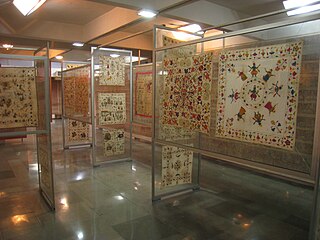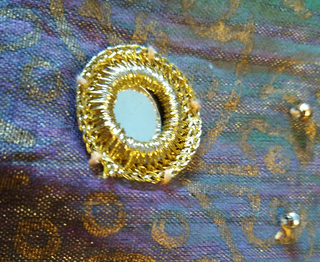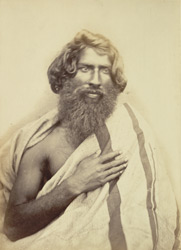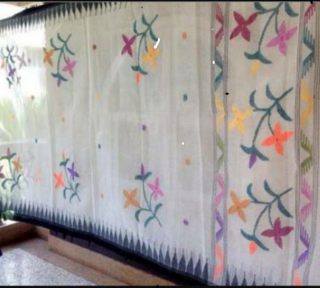Related Research Articles

Embroidery is the art of decorating fabric or other materials using a needle to stitch thread or yarn. Embroidery may also incorporate other materials such as pearls, beads, quills, and sequins. In modern days, embroidery is usually seen on hats, clothing, blankets, and handbags. Embroidery is available in a wide variety of thread or yarn colour. It is often used to personalize gifts or clothing items.

Crewel embroidery, or crewelwork, is a type of surface embroidery using wool. A wide variety of different embroidery stitches are used to follow a design outline applied to the fabric. The technique is at least a thousand years old.

Jamdani is a fine muslin textile produced for centuries in South Rupshi of Narayanganj district in Bangladesh on the bank of Shitalakhwa river.

Paithani is a variety of sari, named after the Paithan town in Aurangabad from state of Maharashtra in India where the sari was first made by hand. Present day Yeola town in Nashik, Maharashtra is the largest manufacturer of Paithani.

Phulkari refers to the folk embroidery of the Punjab region and Gulkari of Sindh in South Asia.

Embroidery in India includes dozens of embroidery styles that vary by region and clothing styles. Designs in Indian embroidery are formed on the basis of the texture and the design of the fabric and the stitch. The dot and the alternate dot, the circle, the square, the triangle, and permutations and combinations of these constitute the design.

In India, about 97% of the raw mulberry silk is produced in the Indian states of Karnataka, Andhra Pradesh, Tamil Nadu and West Bengal. Mysore and North Bangalore, the upcoming site of a US$20 million "Silk City", contribute to a majority of silk production. Another emerging silk producer is Tamil Nadu in the place in where mulberry cultivation is concentrated in Salem, Erode and Dharmapuri districts. Hyderabad, Andhra Pradesh and Gobichettipalayam, Tamil Nadu were the first locations to have automated silk reeling units.
The manufacture of textiles is one of the oldest of human technologies. To make textiles, the first requirement is a source of fiber from which a yarn can be made, primarily by spinning. The yarn is processed by knitting or weaving, with color and patterns, which turns it into cloth. The machine used for weaving is the loom. For decoration, the process of coloring yarn or the finished material is dyeing. For more information of the various steps, see textile manufacturing.

Shisheh or abhla bharat embroidery, or mirror-work, is a type of embroidery which attaches small pieces of mirrors or reflective metal to fabric. Mirror embroidery is common throughout Asia, and today can be found in the traditional embroidery of the Indian subcontinent, Afghanistan, China, and Indonesia.

A Sambalpuri sari is a traditional handwoven bandha (ikat) sari wherein the warp and the weft are tie-dyed before weaving. It is produced in the Sambalpur, Bargarh, Balangir, Boudh and Sonepur districts of Odisha, India. The sari is a traditional female garment in the Indian subcontinent consisting of a strip of unstitched cloth ranging from four to nine meters in length that is draped over the body in various styles.

Odisha Ikat, is a kind of ikat known as Bandhakala and Bandha, a resist dyeing technique, originating from Indian state of Odisha. Traditionally known as "Bandhakala"', "Bandha", '"Bandha of Odisha", it is a geographically tagged product of Odisha since 2007. It is made through a process of tie-dyeing the warp and weft threads to create the design on the loom prior to weaving. It is unlike any other ikat woven in the rest of the country because of its design process, which has been called "poetry on the loom". This design is in vogue only at the western and eastern regions of Odisha; similar designs are produced by community groups called the Bhulia, Kostha Asani, and Patara. The fabric gives a striking curvilinear appearance. Saris made out of this fabric feature bands of brocade in the borders and also at the ends, called anchal or pallu. Its forms are purposefully feathered, giving the edges a "hazy and fragile" appearance. There are different kinds of bandha saris made in Odisha, notably Khandua, Sambalpuri, Pasapali, Kataki and Manibandhi.

The Toda Embroidery, also locally known as "pukhoor", is an art work among the Toda pastoral people of Nilgiris, in Tamil Nadu, made exclusively by their women. The embroidery, which has a fine finish, appears like a woven cloth but is made with use of red and black threads with a white cotton cloth background. Both sides of the embroidered fabric are usable and the Toda people are proud of this heritage. Both men and women adorn themselves with the embroidered cloaks and shawls.
Kotpad Handloom is a vegetable-dyed fabric woven by the tribal weavers of the Mirgan community of Kotpad village in Koraput district, Odisha, India. Cotton sarees with solid border and Pata Anchal, duppatta with typical Buties / motifs, Scolrfs on cotton, silk, handloom stoles, and dress materials are all dyed with organic dyes. The natural dye is manufactured from the aul tree grown in this area. The Kotpad tussar silk saree with tribal art and Kotpad handloom fabrics with natural color is its specialty.

The Kutch Embroidery is a handicraft and textile signature art tradition of the tribal community of Kutch District in Gujarat, India. This embroidery with its rich designs has made a notable contribution to the Indian embroidery traditions. The embroidery, practiced normally by women is generally done on fabrics of cotton, in the form of a net using cotton or silk threads. In certain patterns, it is also crafted over silk and satin. The types of stitches adopted are “square chain, double buttonhole, pattern darning, running stitch, satin and straight stitches”. The signature effect of the colorful embroidery sparkles when small mirrors called abhla are sewn over the geometrically shaped designs. Depending on the tribal sub groups of Rabari, Garasia Jat, and Mutava involved with this craft work many hand embroidered ethnic styles have evolved. These six styles: Suf, khaarek, Paako, Rabari, Garasia Jat, and Mutava.
The Surat Zari / Jari Craft is a textile product of Surat district in Gujarat, India, which is made from yarns of silk and cotton mixed with gold, silver or copper. The zari threads are used to make intricate designs by weaving into generally silk fabrics. Its use is extensive in textile industries and handicrafts. The Surat Zari is either woven on cloth or hand embroidered to form fabric borders or used as part on the body of the cloth. The zaris are used in fabrics made in Varanasi and a few other places in Uttar Pradesh, Tamil Nadu, Karnataka and Andhra Pradesh. Banarasi saris made in Varanasi and Kanjivaram Saris of South India use Surat Zari extensively.

Wangkhei Phee is a textile fabric made of white cotton. It is a product which is protected under the GI registration and is made throughout the Indian state of Manipur and is woven by women. The fabric is transparent, has many designs on its body, and is popularly worn by women of Manipur for marriage ceremonies and other festive occasions.
Moirang Phee is a textile fabric which has a specific design called the "MoirangPheejin" which is woven sequentially on both longitudinal edges of the fabric and oriented towards the center of the cloth, with cotton or silk threads. It is a product which is protected under the GI registration and is made throughout the Indian state of Manipur. It was originally a product of Moirang village.
The Sujani embroidery work of Bihar, is a textile expressive art product, given protection under the GI registration act. It is usually a quilt or bed spread, which was earlier made of old clothes, but is now generally made of easily available fabric with embroidery done with the most simple stitches with motifs narrating stories. It is exclusively made by women in 15 villages of Bhusra in the Gaighat block of Muzaffarpur and a few villages of Madhubani in the Indian state of Bihar.
Madurai Sungudi is a design from Madurai, in the Indian state of Tamil Nadu, which is an exclusive textile product traditionally produced using tie and dye method by the Saurashtrians, who migrated to Madurai under the patronage of King Thirumalai Naicker in the 17th century. The fabric's traditional popular use is as a saree; the fabric is now also used to make shirts, salwars, shawls, handbags, bed sheets and pillow cases. The product has been given protection under the GI registration act.

Meitei clothings, or Meitei attires, or Meitei costumes, or Meitei dresses, or Meitei dressings, or Meitei fabrics, or Meitei garments, or Meitei robes, or Meitei textiles, refer to the traditional clothes of Meitei cultural heritage of Manipur as well as Assam, Bangladesh, Meghalaya, Myanmar (Burma), Nagaland, Tripura, etc.
References
- 1 2 3 4 Ngangbam, mukhomba (9 July 2014). "The artisan embracing family legacy in Shaphee Lanphee – Maisanam Nalini". Manipur Times. Retrieved 8 May 2016.
- 1 2 3 4 5 6 7 8 9 10 "Geographical Indications Journal No. 55" (PDF). Government of India. 29 November 2013. Archived from the original (PDF) on 2 August 2014. Retrieved 8 May 2016.
- ↑ "GI registration for Shaphee Lanphee, Moirang phee, Wangkhei Phee officially handed over to the state". Manipur Times. 30 May 2014. Retrieved 8 May 2016.